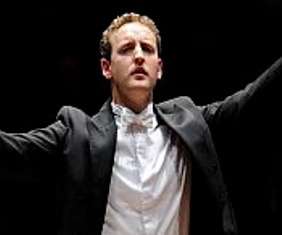|
Back
Francis, Kraggerud Heat up Cincinnati Symphony Cincinnati
Music Hall
03/02/2012 -
Antonin Dvorák: Symphony No. 7 in D-Minor, Op. 70
Felix Mendelssohn: Concerto in E Minor for Violin and Orchestra, Op. 64
Tan Dun: Overture: “Dragon and Phoenix” (from Symphony 1997, Heaven Earth Mankind)
Henning Kraggerud (violin)
Cincinnati Symphony Orchestra, Michael Francis (guest conductor)

M. Francis (Courtesy of C.O.)
There was a dragon on the program by the Cincinnati Symphony Orchestra March 2 at Music Hall, also a firebird. Specifically, Tan Dun’s Overture: “Dragon and Phoenix” (from his Symphony 1997, Heaven Earth Mankind). It was a CSO premiere. However, there was plenty of heat in Mendelssohn’s Violin Concerto, too, as performed by guest artist Henning Kraggerud.
Kraggerud gave the Mendelssohn a perfervid interpretation – after all, the first movement is marked Allegro molto appassionato -- and the emphasis was on drama rather than lyricism. Tempos were brisk, leaving less room for nuance (even the cadenza had an aggressive feel), and the slow movement (Andante) was taken at a clip that somewhat diminished its sense of reverie. By far, the most convincing movement was the finale, which sparkled with virtuosity. Kraggerud made his case with the audience, which called him back for an encore. It was a beautiful one: Kraggerud’s own Preludium in A Minor (inspired, he said, by the solo sonatas of violinist Eugène Ÿsaye, music director of the CSO from 1918-22).
Tan Dun’s ten-minute Dragon and Phoenix, extracted from his epic, 72-minute Symphony 1997, made a fine impression in its CSO premiere. Francis, making his own auspicious debut with the orchestra, led it with gusto, from the opening low brass blasts of the “Dragon’s Dance” to the concluding, jubilant “Hei”! shouted by orchestra and conductor. The cinematic music -- commissioned for ceremonies celebrating the reunification of Hong Kong with the People’s Republic of China in 1997 -- recalled everything from John Williams (Tan’s fellow film composer) to Puccini’s Turandot and even Beethoven, whose Ode to Joy is admixed with Chinese folk song in the final section of the work. The CSO percussion section wielded mallets, (tubular bells, tam-tam) sticks (on Chinese drum heads and sides), cymbals, flexatones and more to exhilarating effect.
Francis, 35, an up-and-comer with the knack for stepping in at the last minute for conductors including Valery Gergiev and John Adams, closed the concert with Dvorák’s Symphony No. 7. Tall and lithe, the British conductor (a former double bassist with the London Symphony Orchestra) cuts a fine figure on the podium. (It does not hurt him that he bears a passing physical resemblance to the legendary Carlos Kleiber.) Francis utilized sweeping, but precise gestures – no funny business -- and conveyed a sense of joy and confidence. He crafted the climax of the opening movement with a sense of inevitability, thereby heightening its emotive power. He summoned deep feeling in the second movement and infused energy and lilt into the Scherzo. He saved the gravitas of the Symphony for the final movement, whose closing, chorale-like motive soared majestically.
Mary Ellyn Hutton
|